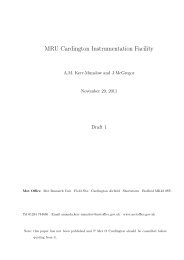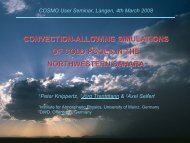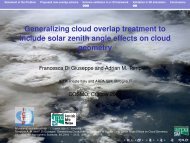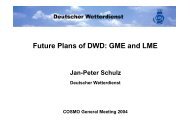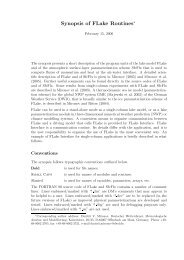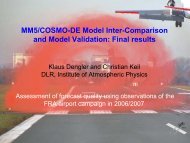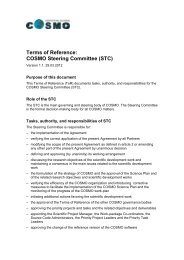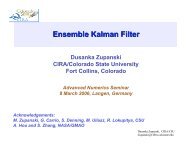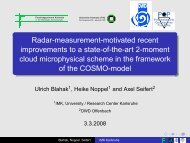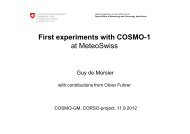- Page 1: Consortium July 2006 for Small−Sc
- Page 4 and 5: Contents ii 4 Working Group on Inte
- Page 6 and 7: Contents iv COSMO Newsletter No. 6
- Page 8 and 9: Editorial 2 We would like to thank
- Page 10 and 11: 1 Working Group on Data Assimilatio
- Page 12 and 13: 1 Working Group on Data Assimilatio
- Page 14 and 15: 1 Working Group on Data Assimilatio
- Page 16 and 17: 1 Working Group on Data Assimilatio
- Page 18 and 19: 1 Working Group on Data Assimilatio
- Page 20 and 21: 1 Working Group on Data Assimilatio
- Page 22 and 23: 1 Working Group on Data Assimilatio
- Page 24 and 25: 1 Working Group on Data Assimilatio
- Page 26 and 27: 1 Working Group on Data Assimilatio
- Page 28 and 29: 1 Working Group on Data Assimilatio
- Page 30 and 31: 1 Working Group on Data Assimilatio
- Page 32 and 33: 1 Working Group on Data Assimilatio
- Page 34 and 35: 1 Working Group on Data Assimilatio
- Page 36 and 37: 1 Working Group on Data Assimilatio
- Page 38 and 39: 1 Working Group on Data Assimilatio
- Page 42 and 43: 1 Working Group on Data Assimilatio
- Page 44 and 45: 1 Working Group on Data Assimilatio
- Page 46 and 47: 1 Working Group on Data Assimilatio
- Page 48 and 49: 1 Working Group on Data Assimilatio
- Page 50 and 51: 2 Working Group on Numerical Aspect
- Page 52 and 53: 2 Working Group on Numerical Aspect
- Page 54 and 55: 2 Working Group on Numerical Aspect
- Page 56 and 57: 2 Working Group on Numerical Aspect
- Page 58 and 59: 2 Working Group on Numerical Aspect
- Page 60 and 61: 2 Working Group on Numerical Aspect
- Page 62 and 63: 2 Working Group on Numerical Aspect
- Page 64 and 65: 2 Working Group on Numerical Aspect
- Page 66 and 67: 2 Working Group on Numerical Aspect
- Page 68 and 69: 2 Working Group on Numerical Aspect
- Page 70 and 71: 2 Working Group on Numerical Aspect
- Page 72 and 73: 2 Working Group on Numerical Aspect
- Page 74 and 75: 2 Working Group on Numerical Aspect
- Page 76 and 77: 2 Working Group on Numerical Aspect
- Page 78 and 79: 2 Working Group on Numerical Aspect
- Page 80 and 81: 2 Working Group on Numerical Aspect
- Page 82 and 83: 2 Working Group on Numerical Aspect
- Page 84 and 85: 2 Working Group on Numerical Aspect
- Page 86 and 87: 2 Working Group on Numerical Aspect
- Page 88 and 89: 3 Working Group on Physical Aspects
- Page 90 and 91:
3 Working Group on Physical Aspects
- Page 92 and 93:
3 Working Group on Physical Aspects
- Page 94 and 95:
3 Working Group on Physical Aspects
- Page 96 and 97:
3 Working Group on Physical Aspects
- Page 98 and 99:
3 Working Group on Physical Aspects
- Page 100 and 101:
3 Working Group on Physical Aspects
- Page 102 and 103:
3 Working Group on Physical Aspects
- Page 104 and 105:
3 Working Group on Physical Aspects
- Page 106 and 107:
3 Working Group on Physical Aspects
- Page 108 and 109:
3 Working Group on Physical Aspects
- Page 110 and 111:
3 Working Group on Physical Aspects
- Page 112 and 113:
3 Working Group on Physical Aspects
- Page 114 and 115:
3 Working Group on Physical Aspects
- Page 116 and 117:
3 Working Group on Physical Aspects
- Page 118 and 119:
3 Working Group on Physical Aspects
- Page 120 and 121:
3 Working Group on Physical Aspects
- Page 122 and 123:
3 Working Group on Physical Aspects
- Page 124 and 125:
3 Working Group on Physical Aspects
- Page 126 and 127:
3 Working Group on Physical Aspects
- Page 128 and 129:
3 Working Group on Physical Aspects
- Page 130 and 131:
3 Working Group on Physical Aspects
- Page 132 and 133:
3 Working Group on Physical Aspects
- Page 134 and 135:
3 Working Group on Physical Aspects
- Page 136 and 137:
4 Working Group on Interpretation a
- Page 138 and 139:
4 Working Group on Interpretation a
- Page 140 and 141:
4 Working Group on Interpretation a
- Page 142 and 143:
4 Working Group on Interpretation a
- Page 144 and 145:
4 Working Group on Interpretation a
- Page 146 and 147:
4 Working Group on Interpretation a
- Page 148 and 149:
4 Working Group on Interpretation a
- Page 150 and 151:
4 Working Group on Interpretation a
- Page 152 and 153:
4 Working Group on Interpretation a
- Page 154 and 155:
4 Working Group on Interpretation a
- Page 156 and 157:
4 Working Group on Interpretation a
- Page 158 and 159:
4 Working Group on Interpretation a
- Page 160 and 161:
4 Working Group on Interpretation a
- Page 162 and 163:
4 Working Group on Interpretation a
- Page 164 and 165:
4 Working Group on Interpretation a
- Page 166 and 167:
4 Working Group on Interpretation a
- Page 168 and 169:
5 Working Group on Verification and
- Page 170 and 171:
5 Working Group on Verification and
- Page 172 and 173:
5 Working Group on Verification and
- Page 174 and 175:
5 Working Group on Verification and
- Page 176 and 177:
5 Working Group on Verification and
- Page 178 and 179:
5 Working Group on Verification and
- Page 180 and 181:
5 Working Group on Verification and
- Page 182 and 183:
5 Working Group on Verification and
- Page 184 and 185:
5 Working Group on Verification and
- Page 186 and 187:
5 Working Group on Verification and
- Page 188 and 189:
5 Working Group on Verification and
- Page 190 and 191:
5 Working Group on Verification and
- Page 192 and 193:
5 Working Group on Verification and
- Page 194 and 195:
5 Working Group on Verification and
- Page 196 and 197:
5 Working Group on Verification and
- Page 198 and 199:
5 Working Group on Verification and
- Page 200 and 201:
5 Working Group on Verification and
- Page 202 and 203:
5 Working Group on Verification and
- Page 204 and 205:
5 Working Group on Verification and
- Page 206 and 207:
5 Working Group on Verification and
- Page 208 and 209:
5 Working Group on Verification and
- Page 210 and 211:
5 Working Group on Verification and
- Page 212 and 213:
5 Working Group on Verification and
- Page 214 and 215:
5 Working Group on Verification and
- Page 216 and 217:
6 Working Group on Implementation a
- Page 218 and 219:
6 Working Group on Implementation a
- Page 220 and 221:
7 External Contributions 214 Figure
- Page 222 and 223:
7 External Contributions 216 Figure
- Page 224 and 225:
7 External Contributions 218 Figure
- Page 226 and 227:
7 External Contributions 220 An Obj
- Page 228 and 229:
7 External Contributions 222 a b c
- Page 230 and 231:
7 External Contributions 224 • Py
- Page 232 and 233:
7 External Contributions 226 lbdcli
- Page 234 and 235:
7 External Contributions 228 MSLP [
- Page 236 and 237:
7 External Contributions 230 22 20
- Page 238 and 239:
7 External Contributions 232 0 -5 -
- Page 240 and 241:
7 External Contributions 234 encour
- Page 242 and 243:
7 External Contributions 236 The Ef
- Page 244 and 245:
7 External Contributions 238 Veloci
- Page 246 and 247:
7 External Contributions 240 WARMRA
- Page 248 and 249:
7 External Contributions 242 1 Intr
- Page 250 and 251:
7 External Contributions 244 Figure
- Page 252 and 253:
7 External Contributions 246 Numeri
- Page 254 and 255:
7 External Contributions 248 Erzgeb
- Page 256 and 257:
7 External Contributions 250 Simula
- Page 258 and 259:
7 External Contributions 252 1.2 1
- Page 260 and 261:
7 External Contributions 254 a) b)
- Page 262 and 263:
7 External Contributions 256 Hartje




